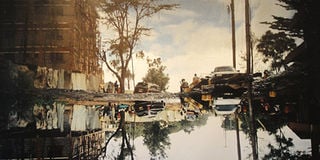Reflections on Nairobi’s Eastlands

Reflections on Mathare by David Mbuthia. PHOTO I William Ongeri
“Where is Nairobi’s Eastlands?” I asked my colleagues in the office. They all said the same thing: the area to the east of Tom Mboya Street – the poorer side of the city, to distinguish it from the more affluent Westlands.
The layout of Nairobi reflects its colonial origins, doesn’t it?
Starting as the last and lingering railway camp before the engineers of the “Lunatic Line” tackled the steep problem of the escarpment, the shape of the swampy settlement was of a three-leafed clover: the European officials and adventurers took the higher and more salubrious ground to the west; the Indian traders and artisans set up in the north; the African labourers and porters were confined to the east and south.
There was an estate called Eastlands. You don’t see it on current city maps, but it was between Eastleigh and Jogoo Road, between Shauri Moyo and Buru Buru. And there is still an Eastlands Crescent that was, presumably, at the heart of it.
I am telling you all this because I was at first puzzled at the sub-title of a superb photographic exhibition that is running at the Nairobi Gallery.
“Grassroots upgraded,” the exhibition is called, with the sub-title, Reflections on Nairobi Eastlands.
Well, what is being reflected is not the original estate but the Nairobi that is at “the other side of the tracks” from Westlands. In fact, the focus is on the eastern slums – particularly on Mathare Valley.
The photographs and videos have been taken by young members of the Kenyan media collective, Slum-TV. They have deliberately given themselves that seemingly pejorative name because, as the exhibition’s blurb says, they are “challenging stereotypes about life in the marginal areas of Nairobi, revealing a dynamic and bustling urban life.”
Perhaps they, too, are guilty of an unbalanced presentation – not dwelling at all on the dire and darker aspects of life in the slums: the sometimes brutalities and desperate prostitution.
Instead, the mood created by photographs is quirky, amusing, and sometimes quite lyrical.
The ordinary becomes an object of interest: a digital radio perched precariously on a piece of rock; a chicken staring at itself in a mirror; a hand holding a creased and dirtied newspaper, no doubt read many, many times; a pair of smart sneakers on the low roof of a makeshift shack; pink sheets hung out to dry along a dusty road; goats grazing on a patch of grass, greened after the rains.
The photographs have been taken with LOMO cameras – a cheaper brand of cameras that make for spontaneity in the shooting and sometimes produce a blurred and arty effect.
“Don’t think. Just shoot” is the motto of Lomography. Many of the photographs have been shot with a fish-eye lens that produces an arresting panoramic and hemispherical image.
There are five short documentaries, also. Each features one character who is making a precarious living in the jua kali world of Mathare: a woman making liquid soap; a potter crafting animals for the tourist market; a young man working with his father in assembling wooden toys; a man reshaping discarded tins into “home banks”; another making shoes out of worn rubber tyres.
There is determination here, application, hard work, ingenuity – and not a little skill.
I was at the gallery on a Sunday morning. For most of the time I was on my own. Then a family arrived: a couple with their two small daughters and a teenage son.
Eventually, we got talking. I learnt that the husband and wife are both professionals. They live in Karen. They had seen the notice for the exhibition as they had been driving along Uhuru Highway.
“I’m very glad we came in,” the father said. “You know, my son will complain if there isn’t bacon for breakfast in the morning. So it’s good that he sees how so many of his countrymen have to survive.”
John Fox is Managing Director, iDC




